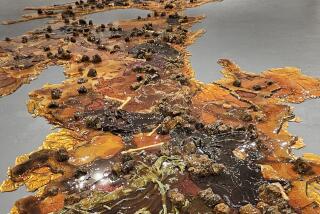What does it mean to be a refugee? An L.A. artist examines her family’s history of displacement and loss
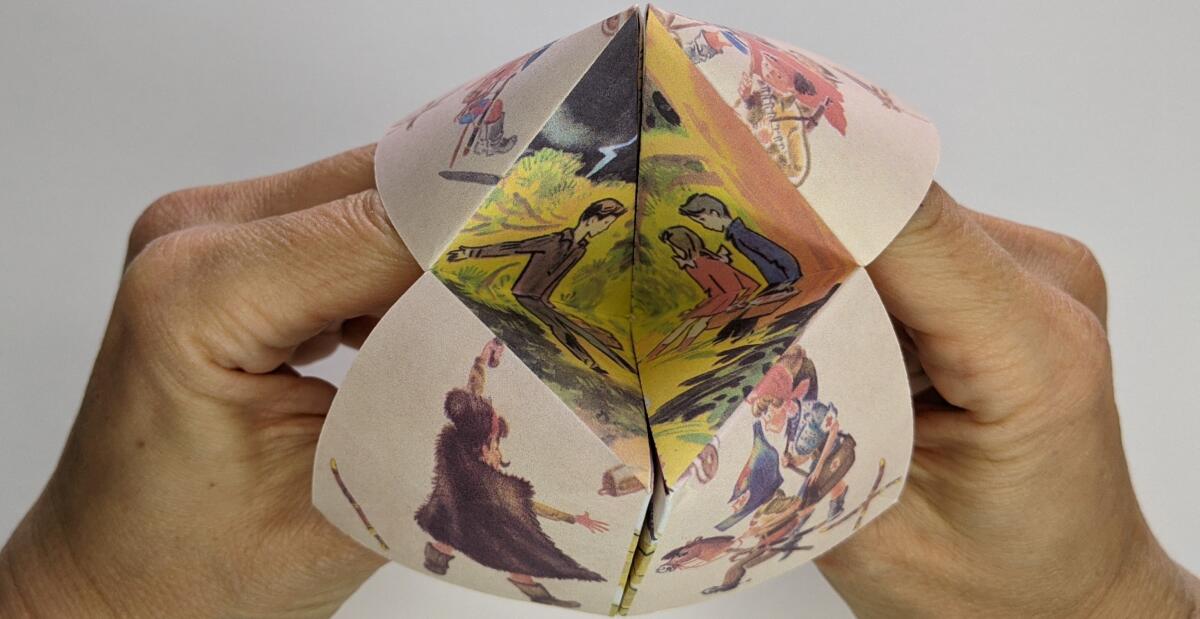
When Jenny Yurshansky’s parents fled Soviet-era Moldova in 1978, they could take only a handful of items with them — what would fit, essentially, into two small suitcases. No valuables were allowed, only essentials for survival; they could bring less than $300 cash and no documentation of education.
Michael and Rima Yurshansky stuffed clothing and blankets into their bags. Rima packed an embroidered infant’s hat and an alphabet baby book for her soon-to-be born daughter, Jenny. Yurshansky was born in Rome months later in January 1979, and her parents — asylum seekers at the time, waiting for permission to gain entry into the U.S. — eventually settled in Northridge. The objects they’d carted from Eastern Europe became an integral part of their new home in California.
Now those items have informed an exhibition centering family migration and the inherited trauma of exile, a timely topic as more than 2.5 million Ukrainians have fled the country in recent weeks since Russia’s invasion. Yurshansky joins a legacy of artists who have probed themes of displacement, trauma and loss entwined with the global refugee crisis, including photographer Tom Kiefer, who saved and photographed migrant and asylum seekers’ belongings discarded when they crossed the U.S.-Mexico border, and Chinese artist and human rights activist Ai Weiwei, whose many art and media projects center on the plight of refugees, freedom of expression and life in exile.
Yurshansky’s solo exhibition, “A Legacy of Loss: There Were No Roses There,” on view at American Jewish University through May 12, is composed of five sculptural installations, a multimedia piece and an audio tour. The titular “There Were No Roses There (Diaspora)” — a climbing rose vine made of welded steel that was charred in a kiln and which features glass roses with brass thorns — traces three generations of her family’s migration to either Argentina, Germany, Israel or the U.S. over the last 100 years. It’s also a record of family members killed in World War II.
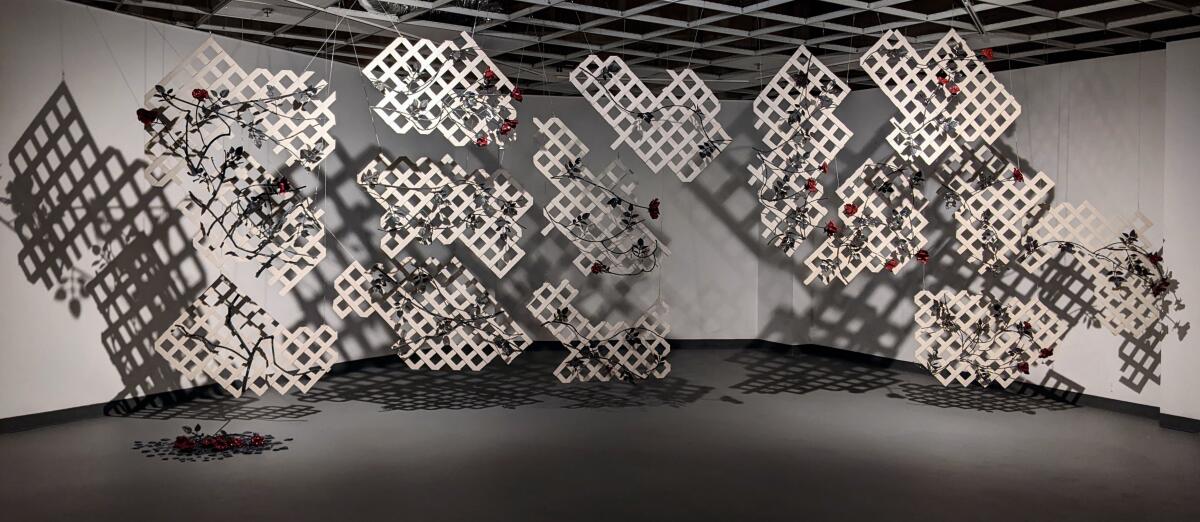
Yurshansky, who now lives in the Lincoln Heights area of Los Angeles, said she was inspired to create the exhibition, which was organized by former AJU chief curator Dr. Rotem Rozental, after trips back to Moldova with her mother in 2016 and 2017.
“I’d gotten an artist grant from Asylum Arts to take my mom back to Moldova for the first time since fleeing,” Yurshansky says. “I wanted to explore this theme of what it means to be a refugee, studying my own family as a case study.”
The exhibition’s through lines are universal, Yurshansky says. “To abandon one’s home and leave everything behind and come someplace entirely unknown, this brings generational trauma,” she explains in this edited conversation. “I think there’s a lot of denial in the U.S. because there’s this myth of Americanness, that our pasts have been erased and our slates wiped clean. That we belong in this space while others don’t. Combined with the fact that our families don’t want to talk about it, it’s too painful. The exhibition is meant to provide a place to have open discussions about this hard reality.”
Your show is especially timely. Do you think about the exhibition differently now?
The series “The Border Will Not Hold,” framed embroideries, has taken on a new dimension in light of Russia’s invasion of Ukraine. The embroideries address how the ideas of nationalism, bigotry and us-versus-them propaganda are weaponized by states, pitting populations against one another. It’s a pattern that we know very well here in the U.S. and, of course, happens worldwide. Russia resuming its place at the center of this pattern is just another inevitable turn of history.
These pieces — each a Moldovan folk embroidery pattern collaged with Soviet-era imagery taken from Cyrillic alphabet primers — explore how systemic suppression, oppression and revisionist propaganda can be masked in charming presentations of folk traditions and materials. The books are filled with Soviet propaganda and, along with the alphabet, they are embedded with jingoistic ideas, notions of who belongs, support of the militarized state and how to be a “good Soviet.” The folk embroidery patterns while beautiful have a much darker side to them. The shadows cast by the delicate embroidery work on the surface of the silk chiffon is a reminder to be wary of both the benign and overt ways in which the threat of nationalism is represented.
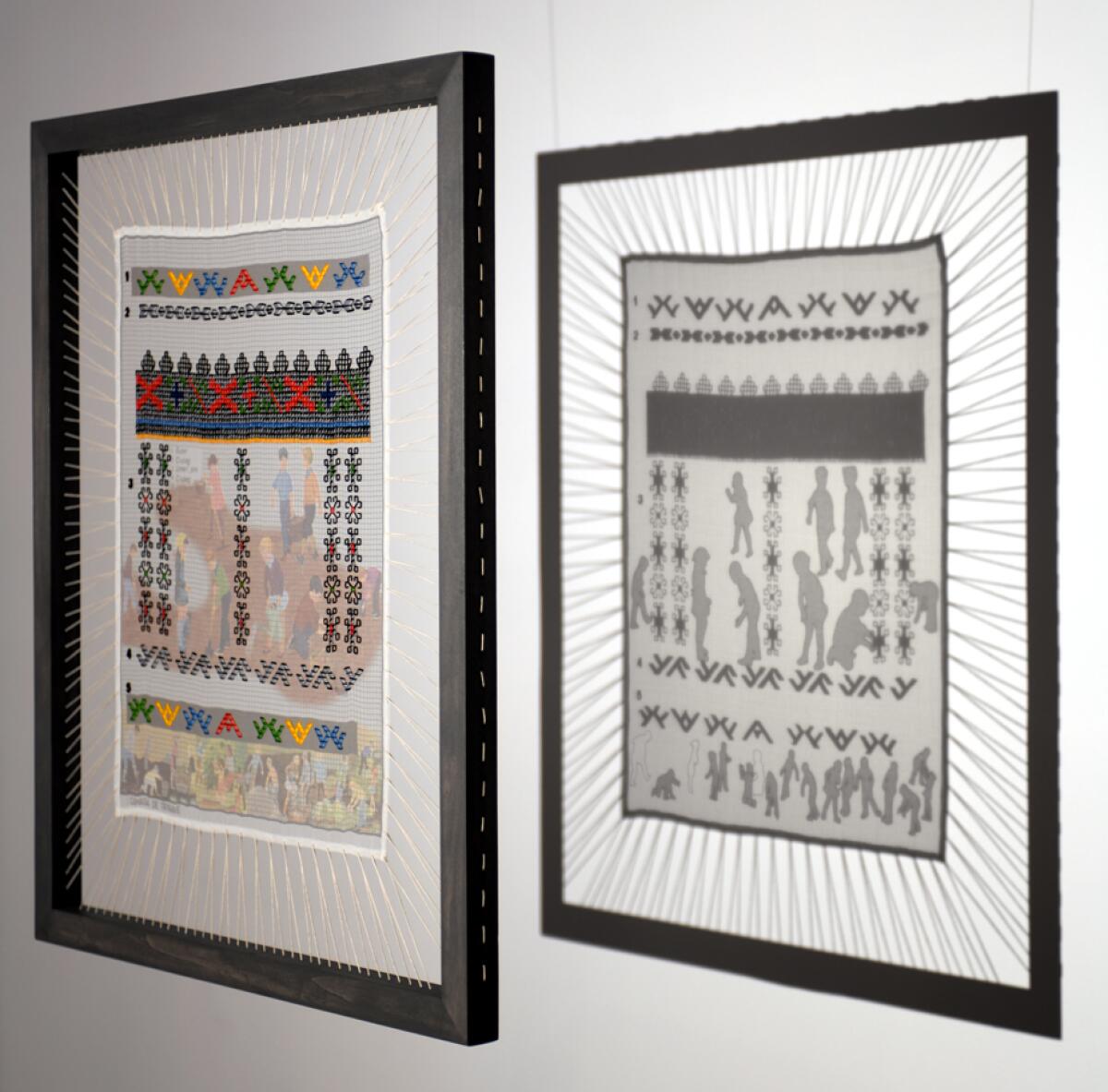
How did you experience the inherited trauma of your parents’ refugee experience?
The period in which my mother became pregnant with me was extremely stressful. Because my mother and father sought to leave the Soviet Union as refugees, they lost their jobs and the waiting period could easily take a year. Her doctor advised her to only gain 15 pounds because there were no epidurals used in the USSR. She literally carried me within her over borders from the Soviet Union, enduring an unnecessary and botched C-section in an Italian hospital because there was no one to advocate for her. Added to that stress, none of my grandparents wanted to join my parents in trying to seek asylum in the U.S. They all immigrated to Israel instead, which was extremely distressing to my mother who was incredibly close to her parents. I was born stateless in Rome while they waited.
The severe stress my mother experienced resulted in physical and psychological traits of mine that are an imprint of my mother’s trauma. I have scoliosis — which does not run in my family — which required spinal fusion surgery. I am significantly shorter and smaller than the rest of my family, and I have ADHD. Research has shown there is often a link between ADHD and childhood trauma. The works in this show are meant to relay to the visitor the difficulty of accessing buried memories due to trauma and how we carry these traumas in our bodies and pass them on to the next generations.
Your mom helped you sew several textile works in the show — how does sewing connect you, your mom and your grandmother?
Sewing, part of my practice, is done to honor my maternal grandmother, a couture seamstress whose dreams were dashed by war; but it is also because she could sew that she survived the war. It was from her that we both learned to sew. Sewing these laboriously detailed pieces with my mom is a strategy I have found that has helped us find a common space to reckon with what it means to be a refugee. My mother will never directly answer my questions about the past. I have found that in the hours we spend sewing and sitting together through silences, sharing the frustrations and rewards of intricate embroidering and large-scale pieces, allows a space for memories to bubble up and come to the surface.
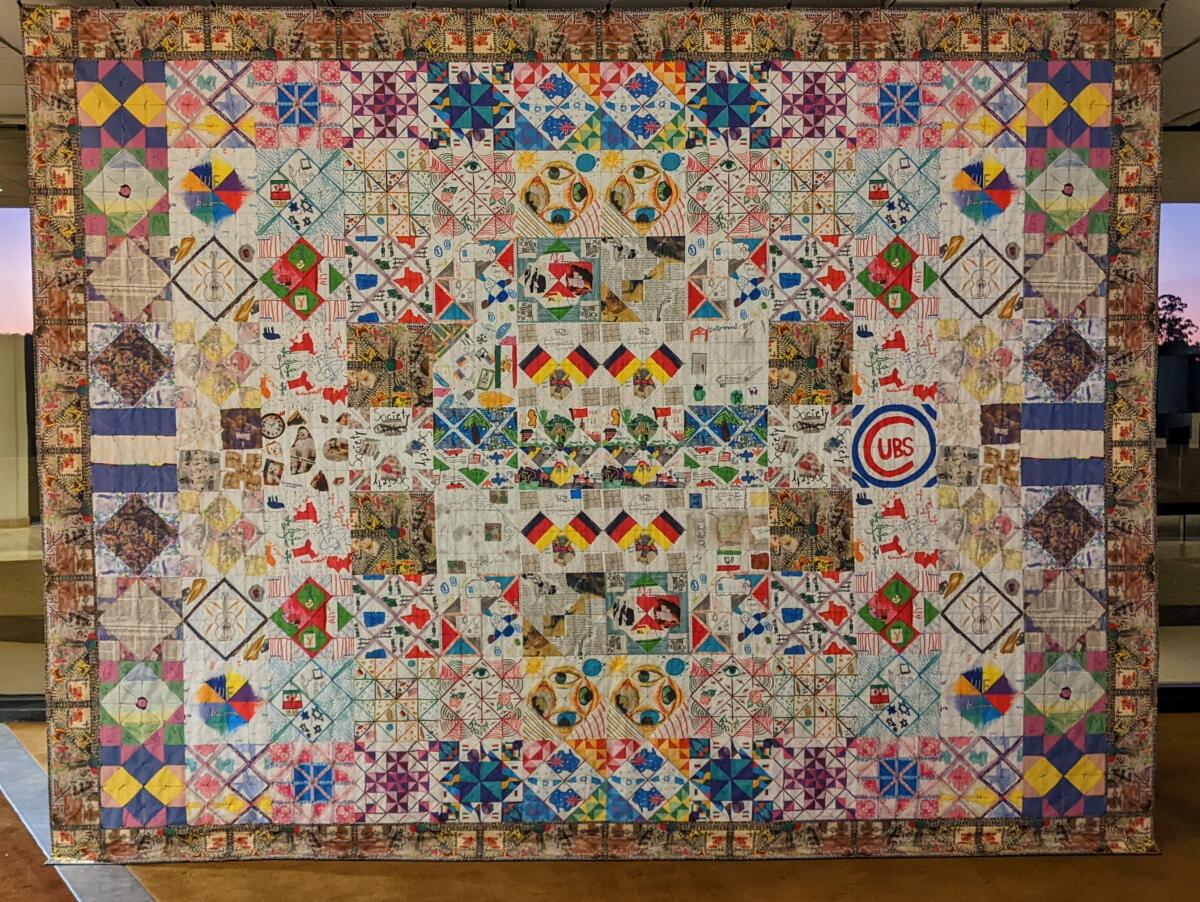
Tell us about “Unfolded Narratives,” a large-scale, quilted tapestry in the exhibition created, in part, by students in Jewish day schools across Los Angeles.
During workshops held at AJU, I led students from schools including Milken Community School, De Toledo High School and Shalhevet High School on a journey to discover their voices by exploring their own family narratives of immigration, change and resilience. These stories traverse the globe from Iran to New York and were expressed through collages, drawn images and narratives which were then folded into playful paper fortune-tellers. With my mother, I have transformed these small, crafted sculptures into “Unfolded Narratives,” which invites us to see how all our stories are connected and pieced together.
How does work in the exhibition speak to a refugee’s experience of hastily gathering family artifacts before fleeing home?
“There Were No Roses There (Echo)” is a wall-based rubbing of a traditional woven carpet from Moldova. The wall surrounding it is stained to mimic tobacco residue. It reflects the complicated meeting points of family traditions, domestic spaces and the various ways questions of home and belonging radiate outward, on a national level. The work, the residue of a carpet, is a negative space — as if a wall carpet were removed, leaving the echo of its fibers behind. One could imagine this being the residue of those who left as well as a shadow of the memories that they hold within them.
There’s an interactive audio guide in the show in which participants can roam AJU’s campus and encounter “blacklisted species” of plants. What’s the concept here and how does it relate to migration?
“Blacklisted: A Planted Allegory (Audio Guide)” explores the sociopolitical constructs of borders and belonging by questioning the scientific classification of plants as “native,” “non-native” or “invasive” species. Listeners are invited to encounter these plants on a choose-your-own-adventure style audio walking tour or as a radio-style drama. It is a web-based field guide for listeners to acquaint themselves with non-native plants commonly found in California. Each plant is performed by an actor who anthropomorphizes it through a narrative, channeling its unique history and experience in arriving and settling here.
These are the stories of generations of migrants. What these plants offer us reflects a landscape that is cultural as much as it is botanical, everything from humble weeds to deliberate landscaping. The experience is meant to familiarize the audience with these plants to better understand the ways in which the landscape is not only botanical but also historical and cultural — the result of human settlement. The listener can experience the plants as a reflection of the people, history, see how they are a part of that narrative, and engage in the often contentious but nevertheless important issues of colonization, migration, borders, citizenship, belonging and otherness.
'A Legacy of Loss'
Where: American Jewish University, Marjorie and Herman Platt Gallery, 15600 Mulholland Drive, Los Angeles
When: by appointment only 10 a.m.-4 p.m. Mondays-Thursdays; walk-through with the artist select Sundays; through May 12
Cost: free
Info: arts.aju.edu; for appointments, arts@aju.edu
More to Read
The biggest entertainment stories
Get our big stories about Hollywood, film, television, music, arts, culture and more right in your inbox as soon as they publish.
You may occasionally receive promotional content from the Los Angeles Times.


